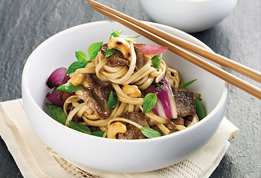 Proteins occupy a crucial place on every menu and budget—and if you’re looking to create new, cost-effective dishes, look to your meats first. One protein particularly well-suited to innovation is Australian Lamb. While the classic rack is a staple main course, lamb, like beef, comes in many different, underutilized cuts—many of which are ideal for flavor-maximizing slow cooking methods that can benefit your operation in myriad ways. Potential benefits include easy-to-assemble dishes; a lowered demand for extra kitchen staff at service time; and optimal order-to-serve times. Cuts to consider for crowd-pleasing, cost-effective dishes:
Proteins occupy a crucial place on every menu and budget—and if you’re looking to create new, cost-effective dishes, look to your meats first. One protein particularly well-suited to innovation is Australian Lamb. While the classic rack is a staple main course, lamb, like beef, comes in many different, underutilized cuts—many of which are ideal for flavor-maximizing slow cooking methods that can benefit your operation in myriad ways. Potential benefits include easy-to-assemble dishes; a lowered demand for extra kitchen staff at service time; and optimal order-to-serve times. Cuts to consider for crowd-pleasing, cost-effective dishes:
Shoulder
Derived from the forequarter, the shoulder is among the most economical and flavor-packed cuts of lamb. It can be cut into shoulder roasts (boneless or bone-in), chops or into chunks for stewing. Ground lamb also often comes from the shoulder. Tender enough to be dry-roasted, its fat content also makes it ideal for braising. Dishes will be marked by aromatic depth, rich flavors and succulent texture.
Dish example: Glazed chai tea-smoked lamb shoulder with vegetable spring rolls
Loin
From the middle-lower section of the rear quarter, lamb loin (the “New York” cut of lamb) can be boned, rolled and tied, or cut into individual loin chops. Beyond premium top sirloin chops and lamb tenderloin, the short loin also presents many flavorful dish options. It can be rolled and sliced into small, round French noisettes, or thicker medallions. Able to be pan-seared and served pink, they present impressively and are versatile enough to be accompanied by a range of seasonal side dishes, from light salads to heartier vegetable purées.
Dish example: Seared lamb medallions with almond and mint pea cream and baby vegetables
Shank
From the latter part of the fore or hind leg, lamb shanks are best roasted or braised to elicit the juices from the bone. They’re almost always cooked in liquid until the meat starts separating from the bone for meltingly tender texture. Yielding a generous amount of meat, shanks can be served whole (a single shank will suffice for one person), or the cooked meat can be stripped from the bone and stewed in cooking juices for multiple portions.
Dish example: Braised lamb shanks with white bean purée
Interested in learning more about different cuts of lamb? Check out Volume 1 of Australian Lamb’s Cuts to Cuisine to explore different cuts, butchery tips and recipes. Volume 2 also coming soon!
Visit our Media Center for short, easy-to-follow videos with comprehensive lamb and beef butchery tips.

